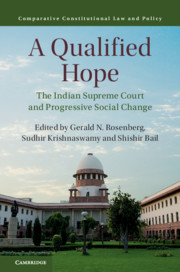16 results
Contents
-
- Book:
- A Qualified Hope
- Published online:
- 19 August 2019
- Print publication:
- 29 August 2019, pp vii-viii
-
- Chapter
- Export citation
Introduction
-
-
- Book:
- A Qualified Hope
- Published online:
- 19 August 2019
- Print publication:
- 29 August 2019, pp 1-20
-
- Chapter
- Export citation
Foreword
-
- Book:
- A Qualified Hope
- Published online:
- 19 August 2019
- Print publication:
- 29 August 2019, pp xv-xvi
-
- Chapter
- Export citation
Acknowledgments
-
- Book:
- A Qualified Hope
- Published online:
- 19 August 2019
- Print publication:
- 29 August 2019, pp xvii-xviii
-
- Chapter
- Export citation
Part IV - Discrimination
-
- Book:
- A Qualified Hope
- Published online:
- 19 August 2019
- Print publication:
- 29 August 2019, pp 293-344
-
- Chapter
- Export citation
Notes on Contributors
-
- Book:
- A Qualified Hope
- Published online:
- 19 August 2019
- Print publication:
- 29 August 2019, pp ix-xiv
-
- Chapter
- Export citation
5 - Public Trust in the Indian Judiciary
- from Part I - The Supreme Court of India – An Institutional Overview
-
-
- Book:
- A Qualified Hope
- Published online:
- 19 August 2019
- Print publication:
- 29 August 2019, pp 123-140
-
- Chapter
- Export citation
Part II - The Supreme Court of India, Social and Political Mobilization
-
- Book:
- A Qualified Hope
- Published online:
- 19 August 2019
- Print publication:
- 29 August 2019, pp 149-240
-
- Chapter
- Export citation
Conclusion
-
-
- Book:
- A Qualified Hope
- Published online:
- 19 August 2019
- Print publication:
- 29 August 2019, pp 345-358
-
- Chapter
- Export citation
Part I - The Supreme Court of India – An Institutional Overview
-
- Book:
- A Qualified Hope
- Published online:
- 19 August 2019
- Print publication:
- 29 August 2019, pp 21-148
-
- Chapter
- Export citation
Copyright page
-
- Book:
- A Qualified Hope
- Published online:
- 19 August 2019
- Print publication:
- 29 August 2019, pp vi-vi
-
- Chapter
- Export citation
Part III - Welfare Rights and the Environment
-
- Book:
- A Qualified Hope
- Published online:
- 19 August 2019
- Print publication:
- 29 August 2019, pp 241-292
-
- Chapter
- Export citation
Appendix 2 - Model Diagnostics and Robustness Checks
- from 5 - Public Trust in the Indian Judiciary
-
- Book:
- A Qualified Hope
- Published online:
- 19 August 2019
- Print publication:
- 29 August 2019, pp 144-148
-
- Chapter
- Export citation
Appendix 1 - Variable Description, Codes and Summary Statistics
- from 5 - Public Trust in the Indian Judiciary
-
- Book:
- A Qualified Hope
- Published online:
- 19 August 2019
- Print publication:
- 29 August 2019, pp 141-143
-
- Chapter
- Export citation

A Qualified Hope
- The Indian Supreme Court and Progressive Social Change
-
- Published online:
- 19 August 2019
- Print publication:
- 29 August 2019
12 - Constitutional Federalism in the Indian Supreme Court
- from Part III - Reactions and Responses to Instability
-
-
- Book:
- Unstable Constitutionalism
- Published online:
- 05 August 2015
- Print publication:
- 17 September 2015, pp 355-380
-
- Chapter
- Export citation

